Intensity of Electromagnetic Waves as a Function of Frequency, Source Distance and Aperture Angle
Par :Formats :
Disponible dans votre compte client Decitre ou Furet du Nord dès validation de votre commande. Le format ePub est :
- Compatible avec une lecture sur My Vivlio (smartphone, tablette, ordinateur)
- Compatible avec une lecture sur liseuses Vivlio
- Pour les liseuses autres que Vivlio, vous devez utiliser le logiciel Adobe Digital Edition. Non compatible avec la lecture sur les liseuses Kindle, Remarkable et Sony
 , qui est-ce ?
, qui est-ce ?Notre partenaire de plateforme de lecture numérique où vous retrouverez l'ensemble de vos ebooks gratuitement
Pour en savoir plus sur nos ebooks, consultez notre aide en ligne ici
- FormatePub
- ISBN8223783541
- EAN9798223783541
- Date de parution13/07/2023
- Protection num.pas de protection
- Infos supplémentairesepub
- ÉditeurDraft2Digital
Résumé
Intensity of Electromagnetic Waves as a function of frequency is usually not treated by the scientific community. The energy transport in Electromagnetic Waves (EMW) calculated by means of the Poynting vector formula, might not yield to correct results, because it only gives an average energy on a surface. There is no reference about the volumetric energy distribution at a distance from the source, nor to the frequency of the EMW.
How can the intensity of EMW be written in terms of frequency and distance to the source?How to calculate the volumetric energy of EMW?How does the intensity change with the aperture angle (solid angle of a cone in space) from the source?How to relate intensity with frequency, area, and aperture angle in one equation?How to obtain the wave equation of the interference caused by slit diffraction to compute the Intensity?In this study, you'll find the answers to the questions above and learn that the result obtained here agrees to the famous Planck equation (E=h f ).
Moreover, a wave equation for the interference pattern produced by slit diffraction is obtained, but calculation of pattern intensities is left for you with the given formulas.
How can the intensity of EMW be written in terms of frequency and distance to the source?How to calculate the volumetric energy of EMW?How does the intensity change with the aperture angle (solid angle of a cone in space) from the source?How to relate intensity with frequency, area, and aperture angle in one equation?How to obtain the wave equation of the interference caused by slit diffraction to compute the Intensity?In this study, you'll find the answers to the questions above and learn that the result obtained here agrees to the famous Planck equation (E=h f ).
Moreover, a wave equation for the interference pattern produced by slit diffraction is obtained, but calculation of pattern intensities is left for you with the given formulas.
Intensity of Electromagnetic Waves as a function of frequency is usually not treated by the scientific community. The energy transport in Electromagnetic Waves (EMW) calculated by means of the Poynting vector formula, might not yield to correct results, because it only gives an average energy on a surface. There is no reference about the volumetric energy distribution at a distance from the source, nor to the frequency of the EMW.
How can the intensity of EMW be written in terms of frequency and distance to the source?How to calculate the volumetric energy of EMW?How does the intensity change with the aperture angle (solid angle of a cone in space) from the source?How to relate intensity with frequency, area, and aperture angle in one equation?How to obtain the wave equation of the interference caused by slit diffraction to compute the Intensity?In this study, you'll find the answers to the questions above and learn that the result obtained here agrees to the famous Planck equation (E=h f ).
Moreover, a wave equation for the interference pattern produced by slit diffraction is obtained, but calculation of pattern intensities is left for you with the given formulas.
How can the intensity of EMW be written in terms of frequency and distance to the source?How to calculate the volumetric energy of EMW?How does the intensity change with the aperture angle (solid angle of a cone in space) from the source?How to relate intensity with frequency, area, and aperture angle in one equation?How to obtain the wave equation of the interference caused by slit diffraction to compute the Intensity?In this study, you'll find the answers to the questions above and learn that the result obtained here agrees to the famous Planck equation (E=h f ).
Moreover, a wave equation for the interference pattern produced by slit diffraction is obtained, but calculation of pattern intensities is left for you with the given formulas.



















